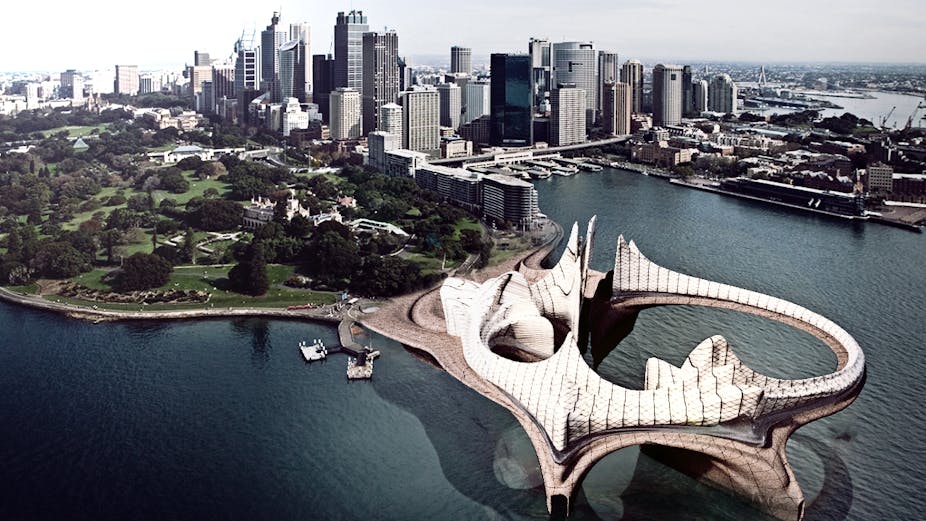The creative team representing Australia at the 14th International Architecture Exhibition – from June 7 to November 23, Felix Laboratories, of which I am a team member, was faced with the particular challenge this year of having no Australian Pavilion in Venice, with the new Denton Corker Marshall building not due to open until 2015.
And so, we devised the Augmented Australia app, using technology to overcome the hurdles of no pavilion and showcase historical and contemporary Australian projects from the last 100 years which, for various reasons, were never actually built. All the while increasing the capacity for the creative team to extend our creative boundaries.
If you download the app now and scan the “trigger images” accompanying this article they will come alive and take you on a virtual journey through these unrealised projects, incorporating three-dimensional (3D) augmented models, images, voiceovers and animations.
Fundamentals 1914 – 2014
The Venice Architecture Biennale is considered to be the “Olympics of Architecture,” at which countries compete for the coveted Golden Lion trophy. Held every two years in the Giardini, the gardens on the Island of Venice constructed by Napoleon Bonaparte, this historic site has been turned into a series of pavilions housing 30 of the 80 countries who participate in the Biennale.
The curator of the exhibition, Rem Koolhaas, possibly one of the most influential architects in modern times, has themed the 2014 exhibition “Fundamentals 1914 – 2014”, asking countries to examine their architecture and its relationship to national identity over the last 100 years.
Provocatively, Koolhaas has claimed that globalisation is affecting regional and national design, creating a global architectural homogeneity.

Augmented reality in Venice
Augmented reality (AR), the technology we use in the app devised for Venice, is essentially an extra layer of information overlayed on the built environment.
The technology has freed the Venice exhibition from the constraints of the physical world to expose the designs of 22 – 11 historical and 11 contemporary – architectural dreams plus a completed version of the new Australian pavilion.
The temporary structure “Cloud Space” (pictured above) is the new spiritual home for the 2014 Australian exhibition, where participants can go to get help from the exhibition staff and partake in the animations and scale models on trigger images under the cloud before venturing off to explore the 1:1 scale models.
The 1:1 scale models are placed throughout the city of Venice, unbuilt but “habitable” through handheld devices using your phone’s GPS co-ordinate system and its camera to position itself within the built environment. This experience lets the participants experience each project’s scale, form and materiality.
In the article you are reading there are three examples of trigger images – a re-imagined Sydney Opera House by Minifie van Schaik (Caught Unawares) – main article image – and a 1952 competition entry by Harry Seidler for the Melbourne Olympic Stadium, below.

There is also the real-world scale digital model of a 1958-designed Pier Nervi cathedral, below, which has been GPS-located in the CBDs of Brisbane, Sydney, Melbourne, Canberra and Perth.

Into the future
The built environment is facing some critical issues in the near future. In the sustainability and climate-change space, architecture can be considered a “waste management” issue, given building life-cycles can be as little as 30 years.
Redundancy in building stock is a natural force in our urban condition, being largely driven by economic factors and property value.
It’s no longer enough to find materials, or energy and resource harvesting products, to help reduce a building’s life-cycle impact on the environment. One of the implications of augmented reality technology is allowing the creation of a hybrid building – half physical, half soft (or virtual).
Google Glass, which I wrote about on The Conversation in 2012, is a dedicated AR device allowing for a more immersive experience through a set of glasses.
Although still unreleased to the general market, this currently offers the best delivery model to utilise unbuilt architecture through AR.
The Augmented Australia app at the Venice Biennale is pioneering it’s just the tip of the iceberg in terms of technology and its application.
The 14th International Architecture Exhibition will take place in Venice from June 7 to November 14 2014.

